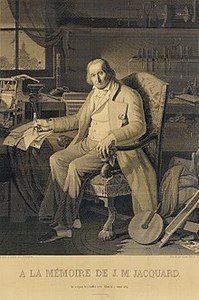The Jacquard Loom is a mechanical loom that uses pasteboard cards with punched holes, each card corresponding to one row of the design. Multiple rows of holes are punched in the cards and the many cards that compose the design of the textile are strung together in order. It is based on earlier inventions by the Frenchmen Basile Bouchon (1725), Jean-Baptiste Falcon (1728) and Jacques Vaucanson(1740). To understand the Jacquard loom, some basic knowledge of weaving is necessary. Parallel threads (the “warp”) are stretched across a rectangular frame (the "loom"). For plain cloth, every other warp thread is raised. Another thread (the “weft thread”) is then passed (at a right angle to the warp) through the space (the “shed”) between the lower and the upper warp threads. Then the raised warp threads are lowered, the alternate warp threads are raised, and the weft thread is passed through the shed in the opposite direction. With hundreds of such cycles, the cloth is gradually created. The potential of Jacquard’s loom was immediately recognized. On April 12, 1805, Emperor Napoleon and Empress Josephine visited Lyon and viewed Jacquard’s new loom. On April 15, 1805, the emperor granted the patent for Jacquard’s loom to the city of Lyon. In return, Jacquard received a lifelong pension of 3,000 francs; furthermore, he received a royalty of 50 francs for each loom that was bought and used during the period from 1805 to 1811.
Although his invention was fiercely opposed by the silk-weavers, who feared that its introduction, owing to the saving of labour, would deprive them of their livelihood, its advantages secured its general adoption, and by 1812 there were 11,000 Jacquard looms in use in France. Initially few Jacquard looms were sold because of problems with the punched card mechanism. Only after 1815 — once Jean Antoine Breton had solved the problems with the punched card mechanism — did sales of looms increase. Jacquard died at Oullins (Rhône), 7 August 1834. Six years later, a statue was erected to him in Lyon, on the site where his 1801 exhibit loom was destroyed.
Not only did the Jacquard loom revolutionize the weaving industry, but it also created the foundation for future computer programmes. The Jacquard head used replaceable punched cards to control a sequence of operations. It is considered an important step in the history of computing hardware. The ability to change the pattern of the loom's weave by simply changing cards was an important conceptual precursor to the development of computer programming and data entry. Charles Babbage knew of Jacquard looms and planned to use cards to store programs in his Analytical Engine. In the late 19th century, Herman Hollerith took the idea of using punched cards to store information a step further when he created a punched card tabulating machine which he used to input data for the 1890 U.S. Census. A large, punched-card-based data processing industry developed in the first half of the twentieth century, dominated by the International Business Machine corporation (IBM), with its line of unit record equipment. The cards were used for data, however, with programming done by plugboards.
Some early computers, such as the 1944 IBM Automatic Sequence Controlled Calculator (Harvard Mark I) received program instructions from a paper tape punched with holes, similar to Jacquard's string of cards. Later computers executed programs from higher-speed memory, though cards were commonly used to load the programs into memory. Punched cards remained in use in computing up until the mid 1980s.



